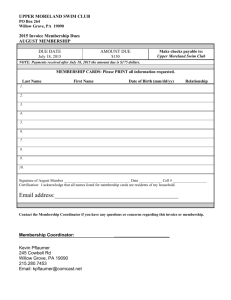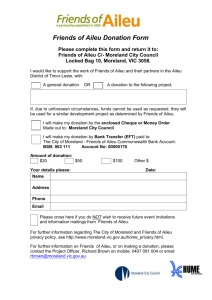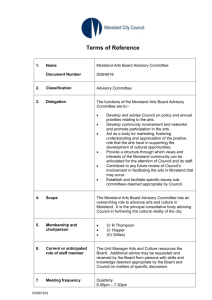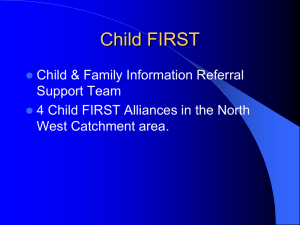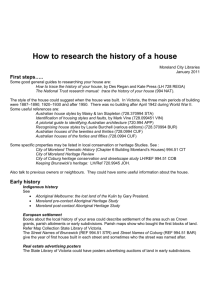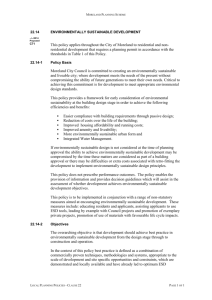David S. Moreland v. Joseph C. Krutzsch, T & L Marketing and U.S.
advertisement
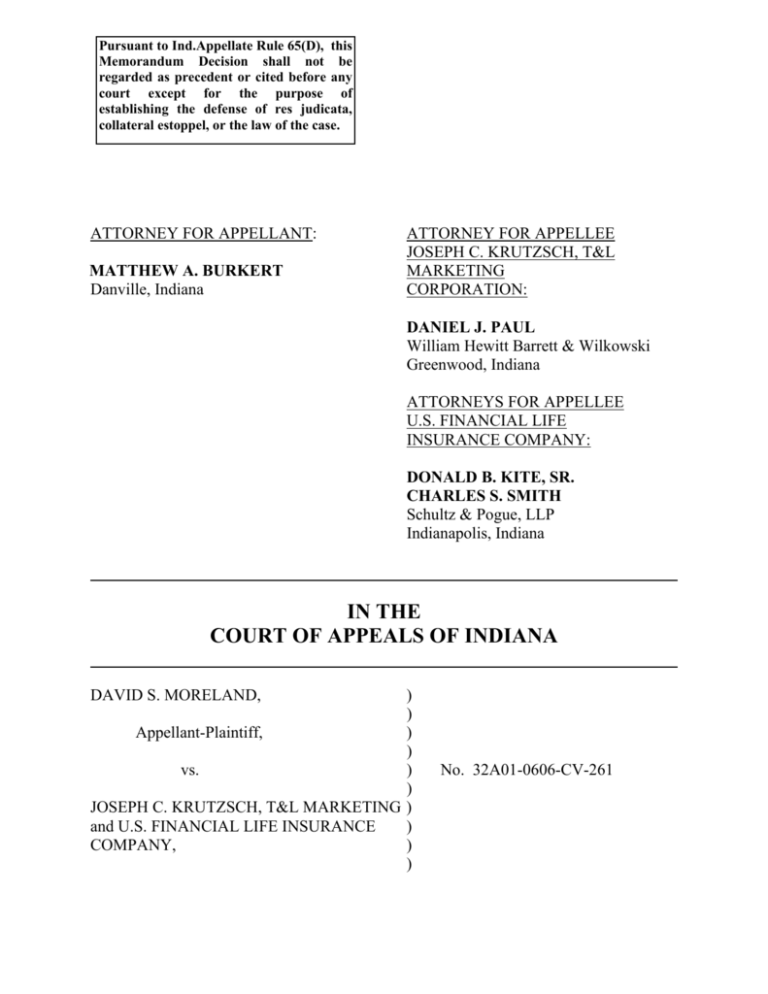
Pursuant to Ind.Appellate Rule 65(D), this Memorandum Decision shall not be regarded as precedent or cited before any court except for the purpose of establishing the defense of res judicata, collateral estoppel, or the law of the case. ATTORNEY FOR APPELLANT: MATTHEW A. BURKERT Danville, Indiana ATTORNEY FOR APPELLEE JOSEPH C. KRUTZSCH, T&L MARKETING CORPORATION: DANIEL J. PAUL William Hewitt Barrett & Wilkowski Greenwood, Indiana ATTORNEYS FOR APPELLEE U.S. FINANCIAL LIFE INSURANCE COMPANY: DONALD B. KITE, SR. CHARLES S. SMITH Schultz & Pogue, LLP Indianapolis, Indiana IN THE COURT OF APPEALS OF INDIANA DAVID S. MORELAND, ) ) Appellant-Plaintiff, ) ) vs. ) ) JOSEPH C. KRUTZSCH, T&L MARKETING ) and U.S. FINANCIAL LIFE INSURANCE ) COMPANY, ) ) No. 32A01-0606-CV-261 Appellees-Defendants. ) ) APPEAL FROM THE HENDRICKS SUPERIOR COURT The Honorable Robert W. Freese, Judge Cause No. 32D01-0408-PL-60 May 25, 2007 MEMORANDUM DECISION - NOT FOR PUBLICATION FRIEDLANDER, Judge David S. Moreland appeals the trial court’s entry of summary judgment in favor of Joseph C. Krutzsch, T&L Marketing Corporation (T&L), and U.S. Financial Life Insurance Company (USFL) (collectively, the defendants) on his claims of breach of contract, fraud, and conversion. Of the several issues presented by Moreland, we find the following dispositive: 1. Are Moreland’s claims barred by their respective statutes of limitations? 2. Are the defendants entitled to summary judgment with respect to the merits of Moreland’s claim for breach of contract? We affirm. 1 1 T&L and USFL argue the grant of summary judgment should be affirmed because Moreland failed to properly designate evidence. They summarize their argument as follows: “Moreland generally designated a totals [sic] of 210 pages of documents in support of his response brief, the majority of which are not authenticated or otherwise admissible. Significantly, neither Moreland’s Designation of Evidence nor his response brief specifically cited to the documents he tendered to the trial court.” Appellees’ Brief at 9. While Moreland’s designation of evidence (as well as his appendix and brief on appeal) is clearly lacking and has hampered our review, we choose to exercise our discretion and reach the merits of his appeal. 2 In 1997, Moreland determined he needed more life insurance to cover an increased debt load with his business. At the time, he had an All American insurance policy with a death benefit of $197,000 (the All American policy). Moreland contacted Krutzsch, an independent insurance agent with whom he had a longtime personal connection. Krutzsch was also the agent who obtained the All American policy for Moreland sometime in the 1980s. Moreland informed Krutzsch that he wished to increase his coverage to $300,000. Krutzsch initially attempted to procure the increased coverage from All American, but was unsuccessful. Krutzsch then found that USFL would be willing to issue such a policy to Moreland. Krutzsch worked with and processed Moreland’s application through T&L, USFL’s general agent in Indiana. 2 According to Moreland, Krutzsch represented to him that Moreland could transfer the funds from his then current All American policy into a policy through USFL and that “the cost of insurance would only be about $1,200.00 to $1,500.00 more to pay per year.” Appellant’s Appendix at 255. Based on this representation, Moreland obtained a universal life insurance policy with Krutzsch’s assistance through USFL (the USFL policy) on June 22, 1997. Thereafter, in August, Moreland accomplished the transfer of his funds from the All American policy ($8448.58) to USFL to initially fund the USFL policy. The written USFL policy provided for annual premiums of $6531.96 (as well as a guaranteed annual cost of insurance of $1383.20). Moreland, however, denies being informed of said premiums and indicates he would not have changed life insurance 2 The record reveals T&L is an agency that assists brokers, such as Krutzsch, in placing insurance with USFL. T&L has an agreement with USFL to act as a general agent in return for the payment of commissions on policies placed through the agency. 3 policies had he known. Further, Moreland claims he did not receive a copy of the written policy at the time and does not recall signing the delivery receipt form for the policy. On or about June 5, 1998, Moreland received a statement from USFL indicating that an annual premium of $6531.96 was coming due on June 22. Moreland immediately contacted USFL. He spoke with Norm Andrews of USFL and asked about the premium notice. Moreland indicated that he recalled applying for life insurance but not with such a high premium. Andrews reviewed the policy terms with Moreland and the amount owed. The two then spoke of the transfer of funds from the All American policy, and Moreland asked about the current cash surrender value of the USFL policy. Andrews explained the surrender charges and indicated the cash surrender value of the policy was zero. Moreland responded that the policy was never explained to him this way and exclaimed, “[T]his is fraud”. Appellees’ Appendix at 275. Moreland then indicated he was going to contact the State Attorney General’s office. Moreland eventually contacted Krutzsch about the situation. According to Moreland, Krutzsch indicated he could “lose his license over this.” Appellant’s Appendix at 256. In an attempt to resolve the issue, Krutzsch suggested lowering the coverage amount of the USFL policy to obtain a satisfactory premium. Moreland rejected this option but agreed to allow Krutzsch to look for another life insurance policy for him. Krutzsch was unable to find a replacement policy and, according to Moreland, failed to further contact Moreland regarding the matter. On or about October 5, 1998, USFL sent a letter to Moreland regarding his failure to pay the annual premium due in June. The letter provided in relevant part: 4 One of the special features of your Universal Life Policy is the Flexibility in the amount and timing of your premium payments. However, sufficient premium must be paid to keep the policy in force. The policy will continue in force as long as the net cash value is sufficient to cover the monthly deduction for the insurance charges or the total premiums paid equals the minimum monthly premium specified in the policy times the number of months the policy has been in force. Our records show that we have not received the June annual premium for the above policy. Please send the planned premiums of $6531.96 by October 20, 1998. If no further payments are received, your insurance coverage will terminate due to failure to meet the minimum premium requirement on October 20, 1998. Id. at 95. Moreland did not pay the premium, and USFL sent him a notice of lapsed policy on October 27, 1998, which indicated the policy had terminated on October 22. In the meantime, Moreland hired an attorney, William Dailey, to look into the insurance matter. On October 14, 1998, Dailey sent letters to T&L and USFL indicating he had been retained by Moreland to “determine the propriety of the transaction which resulted in the issuance of [the USFL policy].” Appellees’ Appendix at 260. Dailey requested “a copy of the policy and any applicable form or contract signed by my client which authorized the use of his funds to pay premiums on the policy.” Id. One month later, on November 20, Dailey sent additional letters indicating: “I have previously requested copies of documents signed by my client relating to the above referenced policy. Please let me know by November 20, 1998, whether those documents will be provided without a court order.” Id. at 262. Dailey apparently received certain requested documents, which he forwarded to Moreland on November 23, 1998. Dailey directed Moreland to review the information and contact the office to discuss the matter. The 5 record reveals no further action taken by Dailey on Moreland’s behalf and no further contact with the defendants. Several years later, on June 21, 2004, Moreland, through different counsel, filed his complaint for damages against the defendants, alleging breach of contract, fraud, and conversion. On March 28, 2005, T&L and Krutzsch filed their respective motions for summary judgment, as well as their designations of evidence. Thereafter, on February 3, 2006, following a stay of deadlines pending mediation, USFL filed its designated evidence and motion for summary judgment. Moreland subsequently responded to the motions for summary judgment, and the trial court held a hearing on said motions on May 26, 2006. That same day, the court issued its order granting summary judgment on the ground that Moreland failed to file his complaint within the applicable statutes of limitations. Moreland now appeals. Our standard of review is well settled: In reviewing a decision of a motion for summary judgment, we apply the same standard as the trial court. The moving party bears the burden of showing that there are no genuine issues of material fact and that it is entitled to judgment as a matter of law. Once this burden has been met, the nonmoving party must respond by setting forth specific facts demonstrating a genuine need for trial, and cannot rest upon the allegations or denials in the pleadings. We review only the designated evidentiary material in the record, construing that evidence liberally in favor of the nonmoving party so as not to deny that party its day in court. Summary judgment is appropriate if there is no genuine issue of material fact and the moving party is entitled to judgment as a matter of law. Ind. Trial Rule 56(C). Boston v. GYN, Ltd., 785 N.E.2d 1187, 1190 (Ind. Ct. App. 2003) (citations omitted), trans. denied. The party appealing a summary judgment ruling has the burden of persuading this court that the ruling was erroneous. Del Vecchio v. Conseco, Inc., 788 6 N.E.2d 446 (Ind. Ct. App. 2003), trans. denied. Upon review, we may affirm the grant of summary judgment on any legal basis supported by the designated evidence. Anderson v. Four Seasons Equestrian Ctr., Inc., 852 N.E.2d 576 (Ind. Ct. App. 2006), trans. denied. 1. The trial court granted summary judgment in favor of the defendants on the basis that Moreland failed to timely file his complaint within the applicable statute of limitations for each claim. Moreland argues that all of his claims were timely brought and, therefore, summary judgment was improperly granted. Statutes of limitation are favored because they afford security against stale claims and promote the peace and welfare of society. Silvers v. Brodeur, 682 N.E.2d 811 (Ind. Ct. App. 1997), trans. denied. “They are enacted upon the presumption that one having a well-founded claim will not delay in enforcing it.” Id. at 813. “The defense of a statute of limitation is peculiarly suitable as a basis for summary judgment.” Id.; see also Del Vecchio v. Conseco, Inc., 788 N.E.2d at 449. “Under Indiana’s discovery rule, a cause of action accrues, and the statute of limitation begins to run, when the plaintiff knew or in the exercise of ordinary diligence could have discovered that an injury had been sustained as a result of the tortious act of another.” Del Vecchio v. Conseco, Inc., 788 N.E.2d at 449. It is not necessary that the full extent of the damage be known or even ascertainable but only that some ascertainable damage has occurred. Del Vecchio v. Conseco, Inc., 788 N.E.2d 446. The discovery rule applies to both tort and contract claims. Id. 7 At the heart of this lawsuit is Moreland’s claim that Krutzsch misrepresented the policy Moreland was obtaining through USFL. According to Moreland, Krutzsch assured him that “the cost of insurance would only be about $1,200.00 to $1,500.00 more to pay per year.” Appellant’s Appendix at 255. Moreland claims he would not have transferred the funds from his All American policy to USFL had he been informed that he would actually owe annual premiums of $6531.96 for the USFL policy. A year after the allegedly false assurances from Krutzsch, Moreland received a premium due notice from USFL. Surprised by the $6531.96 premium listed on the notice, Moreland called USFL on June 5, 1998 to inquire. Upon speaking with Norm Andrews, a USFL representative, Moreland discovered that his policy with USFL called for such a premium, the majority of the transferred funds from All American had been applied to pay the first-year premium, and due to surrender charges the cash surrender value of the USFL policy was zero. Moreland informed Andrews that the policy had never been explained to him in such a way, and he exclaimed, “[T]his is fraud”. Appellees’ Appendix at 275. At the conclusion of his heated conversation with Andrews, Moreland indicated he was going to contact the State Attorney General’s office about the matter. Certainly, after his discussion with Andrews, if not at the moment he received the premium due notice, Moreland knew or in the exercise of ordinary diligence could have discovered that he had sustained some ascertainable damage (i.e., loss of the funds transferred from his All American policy) as a result of Krutzsch’s false assurances. See Del Vecchio v. Conseco, Inc., 788 N.E.2d 446. We therefore conclude that the cause of 8 action accrued, at the latest, on June 5, 1998. We now address the statute of limitations with respect to each claim alleged in the complaint. Moreland’s fraud claim is based on the defendants’ alleged “material misrepresentation of the cost of [the] life insurance policy,” which he relied on to his detriment by transferring the funds from his All American policy to USFL. Appellant’s Brief at 12. Moreland does not dispute that the applicable statute of limitations for fraud claims is six years. See Ind. Code Ann. § 34-11-2-7(4) (West 1999). He claims, however, that the running of the statute of limitations was tolled by fraudulent concealment. We cannot agree. I.C. § 34-11-5-1 (West 1999) provides: “If a person liable to an action conceals the fact from the knowledge of the person entitled to bring the action, the action may be brought at any time within the period of limitation after the discovery of the cause of action.” We have explained: The law narrowly defines concealment, and generally the concealment must be active and intentional. The affirmative acts of concealment must be calculated to mislead and hinder a plaintiff from obtaining information by the use of ordinary diligence, or to prevent inquiry or elude investigation. There must be some trick or contrivance intended by the defrauder to exclude suspicion and prevent inquiry. Mere lack of knowledge of a cause of action is not enough to constitute concealment and toll the running of the statute. A plaintiff bears the burden of proving that a statute of limitations should be tolled, which includes demonstrating the use of reasonable care and diligence to detect the alleged cause of action. Olcott Int’l & Co., Inc. v. Micro Data Base Sys., Inc., 793 N.E.2d 1063, 1072 (Ind. Ct. App. 2003) (internal quotations and citations omitted), trans. denied. 9 Moreland argues that T&L and USFL actively concealed facts by their failure to provide a copy of the life insurance policy transaction documents to him when he inquired, through Dailey, in October and November 1998. Further, he claims that he only became aware of forged signatures 3 and substituted policy cost illustrations through discovery after this litigation commenced. Even assuming for the sake of argument that the defendants did not provide the documents requested by Dailey, Moreland’s fraudulent concealment argument fails. We conclude as a matter of law that as of June 5, 1998, Moreland was apprised of sufficient facts to discover his cause of action for fraud. As of that date, Moreland was fully informed by Andrews regarding the USFL policy, including the annual premium, the status of his transferred funds from the All American policy, and the cash surrender value of the USFL policy. Moreland was, of course, also aware of Krutzsch’s alleged contrary representations, which had originally induced Moreland into contracting with USFL and transferring the funds from his All American policy. In fact, in his discussion with Andrews, Moreland alleged fraud, indicating the policy had never been explained to him in such a way. The defendants’ alleged tardiness in providing documents to Moreland simply did not affect Moreland’s ability to ascertain the fact that he had a cause of action against them for fraud. Therefore, because Moreland filed his complaint more than six 3 We note that Moreland generally claims his signature was forged on “certain documents”. Appellant’s Brief at 8. The designated evidence, however, does not specifically identify each document that contains an allegedly forged signature. 10 years after June 5, 1998, the trial court properly granted summary judgment in favor of the defendants in this regard. We now turn to the conversion claim, in which Moreland seeks treble damages and claims the defendants criminally converted the money that he transferred to the USFL policy from his All American policy. We need not reach the questionable merits of said claim because it too is barred by the applicable statute of limitations, here two years. See I.C. § 34-11-2-4(2) (West 1999). In an attempt to avoid the two-year statute of limitations, Moreland asserts that the doctrine of continuing wrong tolled the running of the statute of limitations. Specifically, he claims: “The facts most favorable to Moreland indicate the Defendants’ continuous and systematic depletion, month-bymonth, for the years 1998 through 2004; even after the Plaintiff filed his cause of action for conversion.” Appellant’s Brief at 25 (emphasis in original). The doctrine of continuing wrong is used to define when an act, omission, or neglect took place. Crowe, Chizek, and Co., L.L.P. v. Oil Tech., Inc., 771 N.E.2d 1203 (Ind. Ct. App. 2002), trans. denied. It applies where an entire course of conduct combines to produce an injury, rather than when a single act in the sequence produces the injury. Id. “In essence, the doctrine of continuing wrong will not prevent the statute of limitations from beginning to run when the plaintiff learns of facts that should lead to the discovery of his cause of action even if his relationship with the tortfeasor continues beyond that point.” Id. at 1210; see also Bambi’s Roofing, Inc. v. Moriarty, 859 N.E.2d 347, 356 n.5 (Ind. Ct. App. 2006) (“[t]he statute of limitations is tolled until the plaintiff 11 learns of facts that should lead to discovery of his cause of action even if his relationship with the tortfeasor continues beyond that point”). In the instant case, it is undisputed that Moreland did not make the annual premium payments required by the USFL policy in 1998 or thereafter. It is also undisputed that USFL fully informed Moreland the policy would terminate if he did not make a payment by October 20, 1998. At the end of October 1998, Moreland received notice from USFL that the policy had lapsed due to nonpayment of premiums. While Moreland may dispute the propriety of USFL’s retention of the transferred funds from the All American policy, he cannot reasonably contest the fact that by October (if not June) 1998, he had learned of facts that should have led to the discovery of his cause of action for conversion. In other words, by sometime in 1998, Moreland clearly knew that USFL was knowingly or intentionally exerting control over the transferred funds without his consent and that USFL had no intention of refunding his money. 4 Therefore, the trial court properly determined Moreland’s conversion claim was barred by the two-year statute of limitations. With respect to the breach of contract claim, however, we cannot agree with the trial court that the claim is barred by the statute of limitations. The parties dispute, as they did below, whether the applicable statute of limitations for this claim is six years or ten years. I.C. § 34-11-2-9 (West 1999) provides for a six-year statute of limitations with Ind. Code Ann. § 34-24-3-1(a) (West, PREMISE through 2006 2nd Regular Sess.) provides: “A person who knowingly or intentionally exerts unauthorized control over property of another person commits criminal conversion, a Class A misdemeanor.” 4 12 respect to actions based on “promissory notes, bills of exchange, or other written contracts for the payment of money”. I.C. § 34-11-2-11 (West, PREMISE through 2006 2nd Regular Sess.), on the other hand, provides for a ten-year statute of limitations for actions “upon contracts in writing other than those for the payment of money, and including all mortgages other than chattel mortgages, deeds of trust, judgments of courts of record, and for the recovery of the possession of real estate”. In a rather cursory fashion, T&L and USFL claim on appeal that the ten-year statute of limitations does not apply because a life insurance contract is a written contract for the payment of money. On more than one occasion, however, we have applied the ten-year statute of limitations provided in I.C. § 34-11-2-11 in the context of a life insurance policy. See Perryman v. Motorist Mut. Ins. Co., 846 N.E.2d 683, 687 (Ind. Ct. App. 2006) (“[I.C.] § 34-11-2-11 encompasses the statute of limitations applicable to an action based upon an insurance contract”); Del Vecchio v. Conseco, Inc., 788 N.E.2d 446 (statute applied in contract dispute regarding whole life insurance policy). We find no reason to hold otherwise in this case. Therefore, Moreland’s claim for breach of contract was timely filed. 2. We now turn to the merits of Moreland’s sole remaining claim. In this regard, Moreland argues the defendants breached the life insurance contract by “wrongfully terminating his policy.” Appellant’s Brief at 12. It appears to be Moreland’s belief that USFL was required to keep the $300,000 policy in force until September or October 2004, without receiving any further premium payments from him. See id. at 19 (“there should have been sufficient funds in the account to avoid a lapse of the policy until 13 September or October 2004”). His position is entirely without merit and can only be explained (if at all) by a fundamental misunderstanding of the difference between premiums and the cost of insurance. 5 The USFL policy clearly called for annual premiums of $6531.96, which were due on June 22 of each year. The policy further provided in relevant part as follows: Continuation of Coverage If you do not pay a premium, we will keep your policy in force so long as the cash value is enough to pay the amount of the monthly deductions as they fall due. Target Premium Guarantee During the first seven policy years following the policy date, this policy will not lapse even if the cash value is negative provided that (a) exceeds (b), where: (a) is the total premiums paid since the policy date less the sum of any outstanding policy loan and any partial surrenders taken; and (b) is one twelfth of the annual target premium…multiplied by the number of policy months since the policy date. Appellant’s Appendix at 187. According to the 1998 annual statement, as of June 22, 1998, Moreland’s policy had a total fund value of $7737.47, a surrender charge of $10,776.00, and a cash surrender value of zero. Because the cash value was zero (or 5 For example, Moreland states: Information received by Moreland from USFL in October or November 1998…indicated that Moreland had $7,737.47 in Moreland’s account after the first year of insurance coverage. This indicated that the actual cost of insurance was only about $1,100.00 for the first year. Information bearing USFL cost information indicates a “Guaranteed Annual Cost” of $1,383.20. Moreland could not receive any information from the Defendants as to the necessity for Moreland to send in an additional $6,531.96 when the cost of insurance was only (approximately) $1,100.00 for the first year and there was more than enough money in Moreland’s account to cover the cost of insurance for additional years. Appellant’s Brief at 9 (citations to record omitted). What Moreland fails to recognize is that he was contractually required to cover the premiums due, not just the cost of insurance. 14 actually negative), 6 the continuation of coverage provision could not save Moreland’s policy from lapsing due to his nonpayment of premiums. While the second contractual provision set forth above kept the policy from immediately lapsing after Moreland’s nonpayment of the premium, this provision could not indefinitely save the policy from lapsing. Rather, sometime in early October 1998, (b) became greater than (a), as the terms are defined above. 7 At that point, USFL could, and eventually did, terminate the policy due to nonpayment of premiums. As a matter of law, we find that USFL did not breach the insurance contract by terminating the lapsed policy on October 22, 1998. Therefore, summary judgment was properly granted in favor of the defendants with respect to Moreland’s claim for breach of contract. Judgment affirmed. KIRSCH, J., and RILEY, J., concur. 6 With respect to “cash value” the policy provides in relevant part: “At any time, you may surrender this policy for its cash value. The cash value is the policy value on the date of surrender, less any amounts owed on the policy, and less any surrender charges.” Id. at 189. Thus, as of June 22, 1998, the cash value was negative $3038.53 ($10,776.00 minus $7737.47). 7 Application of this provision requires some simply algebra. The policy lapses once (b) equals or exceeds (a). Here, (a) = 8448.58 and (b) = 1/12 x 6531.96 x X (where X is the number of months since the policy originated on June 22, 1997). We can solve for X as follows: 8448.58 = 1/12 x 6531.96 x X X = (8448.58 x 12)/6531.96 X = 15.521 In other words, the policy lapsed after about fifteen and one-half months from the time it originally went into effect. 15

